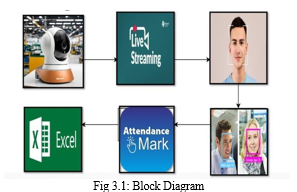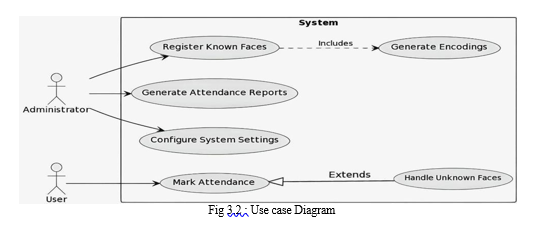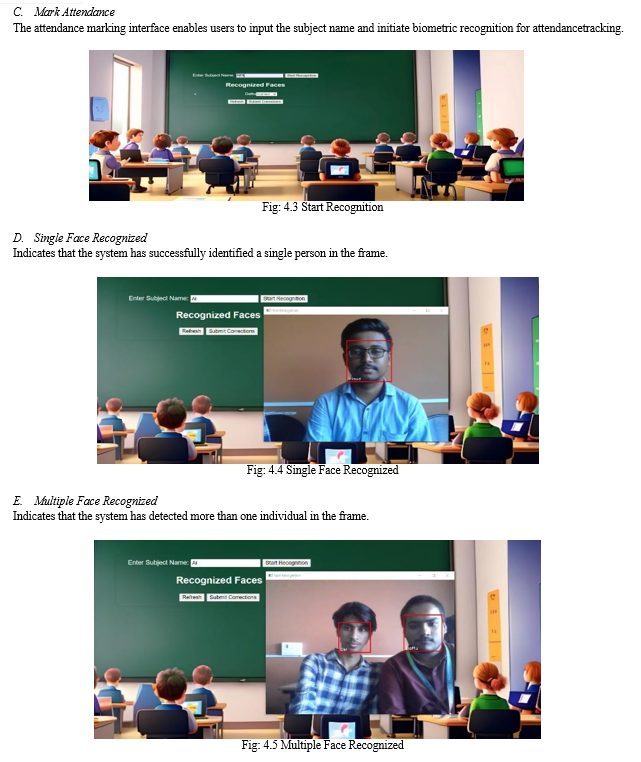Ijraset Journal For Research in Applied Science and Engineering Technology
- Home / Ijraset
- On This Page
- Abstract
- Introduction
- Conclusion
- References
- Copyright
An Automated Approach for Classroom Attendance Using OpenCV
Authors: A Bhuvan Dattu, C Govind Teja, HM Omprakash, Vinod Kumar, Dr. Phanindra Reddy K
DOI Link: https://doi.org/10.22214/ijraset.2024.61799
Certificate: View Certificate
Abstract
The \"AI Attendance: Automated Attendance Monitoring System\" employs artificial intelligence and facial recognition to revolutionize attendance tracking, replacing inefficient methods like roll calls and ID cards. This system eliminates manual record-keeping, reducing administrative burdens while ensuring accurate real-time identification of individuals\' attendance. Technologies such as Flask Framework, OpenCV, and Pandas Library are utilized to develop a user- friendly web interface for face registration and attendance marking. With Pickle for serialization, registered faces persist seamlessly, enhancing efficiency and accuracy in attendance monitoring across various sectors.
Introduction
I. INTRODUCTION
Automating attendance tracking has become a necessity in contemporary educational and corporate environments, aiming to address inefficiencies and combat the risks associated with proxy attendance. This initiative primarily focuses on two key objectives: streamlining the attendance monitoring process through the integration of advanced technologies and eliminating fraudulent practices like proxy attendance that compromise the integrity of attendance records. Traditional methods of attendance tracking, including manual roll calls and ID card scanning, are fraught with in accuracies and vulnerabilities, leading to significant administrative burdens and undermining the reliability of attendance data. Recent statistics indicate an average error rate of 7-10% in manual attendance tracking, with instances of proxy attendance contributing substantially to these inaccuracies. To tackle these challenges head-on, the incorporation of cutting-edge technologies such as artificial intelligence and facial recognition offers a promising solution. By automating identification and verification processes, these technologies enable real-time and precise recording of individuals' attendance, while simultaneously reducing administrative overhead. Furthermore, the utilization of frameworks like Flask, libraries like Pandas, and tools like OpenCVfurther enhances the efficacy and reliability of automated attendance tracking systems. These technologies facilitate the development of user- friendly interfaces and seamless data management, marking a significant advancement in attendance monitoring practices. This introduction sets the stage for an exploration of how the convergence of technology and innovation revolutionizes traditional attendance tracking methods, ushering in an era of heightened efficiency and accountability.
II. LITERATURE REVIEW
- Xuexiao Chen “Study on Student Attendance System Based on Face Recognition”. The session outlines a process to improve an identification system, which involves five key components: student registration, face detection, evaluation of face results, cloud storage, and a result interface During student registration, face images are captured in various expressions for each student. Face detection employs the Haar cascade technique for real-time recognition. The evaluation of face results is based on a developed program that compares the data from a database to identify individuals. Cloud storage is used for storing and managing student data, while the result interface allows easy access and editing of information. The study also uses deep learning-based face recognition algorithms and materials, achieving the highest average accuracy and total training time in experimental results. In experimental results with 25subject testers, the proposed model achieved the highest average accuracy of 97.00% and a total training time of 182.01 seconds, outperforming the ED and LDA methods.
- Mohammed Y. Kamil introduced “Facial Recognition Technology-Based Attendance Management System Application in Smart Classroom”. The paper discusses the need for automating attendance registration in educational and governmental institutions, as traditional methods are time-consuming and prone to errors, including fraud. Traditional systems like paper-and-pen or attendance lists have various drawbacks, and the reliance on paper documents makes attendance recording unsafe and inefficient. To address these issues, the paper introduces an attendance recording system based on facial recognition, which leverages AI to identify individuals. The system has two mainphases: face detection and face recognition, with thelatter comparing a person's face to a database. Despite challenges like varying lighting and seating distances, the proposed system achieved 100% accuracy when tested on thirty students. It's cost- effective and requires minimal physical components, making it a promising solution for automated attendance registration.
- Khawal Alhanaee et.al projected “Face Recognition Smart Attendance System using Deep Transform Learning”. The paper discusses the growing significance of face identification inbiometric authentication, particularly in applications like attendance management and access control systems. These systems are crucial for organizations but can be complex and time-consuming to manage. The paper introduces a facial recognition attendance system based on deep learning convolutional neural networks, utilizing transfer learning with three pre-trained networks. The results demonstrate that this approach achieves high prediction accuracy and reasonable training times, making it a promising solution for attendance management. The paper presents a facial recognition attendance system based on deep learning convolutional neural networks (CNN). The approach involves multiple stages, including data collection from an iPhone 12 camera, data pre-processing, data augmentation, choice of pre-trained networks (SqueezeNet, AlexNet, and GoogleNet), pre-trained network tuning, and training. Data augmentation techniques like rotation and scaling are employed to enhance the dataset, and pre-trained networks are fine-tunedfor the specific classification task. The system achieves high prediction accuracy and reasonable training times, making it a promising solution for facial recognition in attendance management.
- Ghani Rizky Naufal et.al put forward “Deep Learning-Based Face Recognition System For Attendance System”. The paper[4] outlines are search effort focused on developing a face recognition system using deep learning and a camera-based approach to enhance accuracy and prevent fraud in the attendance process. There search aims to create a face recognition module that can detect faces in live video captured by a camera. The model architecture for the system consists of essential components such as cameras, face prints, databases, and algorithms for comparing face prints. The cascade classifier is used to detect and locate faces in images, and the system employs OpenCV to read image and feature files, convert them into NumPy Arrays, and display the detected faces. The algorithm is designed in Python to accept input images, identify faces, compare them with a database, and provide output with student information and attendance status, with a focus on accurate face recognition using facial texture analysis. The system effectively detects and matches faces from live camera input to the database, demonstrating successful identification and display ouput. This achieving an impressive accuracy rate of 95.23%.
- Ahmad S. Lateef et.al introduced “Face Recognition -Based Automatic Attendence System in a Smart Classroom”. The study focuses on automating attendance registration in smart classrooms using advanced technologies. Traditional methods have limitations in terms of safety, accuracy, and efficiency, prompting the exploration of alternatives, including face recognition technology. The research presents an integrated attendance registration system based on the YOLOv7 algorithm, which effectively recognizes students' faces, achieving an impressive accuracy of 100%. Comparative analysis with other methods reaffirms the system's promise and reliability for automating attendance registration in educational settings.
- Shubham R Bhandari et.al advanced “A Surveyon Automated Student Attendence Management System using Face Recognition”. Maintaining student attendance records is vital for educational institutions. Some prefer manual methods, while others opt for automation to streamline the process. Manual methods, such as oral reporting or physical sheets, can be time-consuming and prone to data loss if documents are misplaced. Moreover, there a risk of students marking attendance on behalf of others. In contrast, automated attendance systems, including various biometric options like face recognition, eliminate these issues and reduce human errors. [6]Face recognition, a reliable biometric method, is proven to provide optimal identity verification results.
III. METHODOLOGY
To begin the project setup, the necessary libraries such as OpenCV, Flask, and Pandas will be installed. Following this, a new Flask project will be created, and the required directories and files will be set up to organize the code effectively.
Moving on to face registration, a web interface will be implemented using HTML, CSS, and JS to facilitate user interaction. OpenCV will be employed to capture images and detect faces during registration. The face recognition model will then be utilized to recognize and store faces in a database, which can be managed using Pandas, ensuring efficient data organization.
For attendance marking, another web interface will be created, enabling users to mark attendance conveniently. OpenCV will be leveraged to capture video frames in real-time and detect faces within them. The face recognition model will then identify registered faces, marking their attendance accordingly.
Database management will be handled using Pandas to effectively manage the database of registered faces and attendance records. Serialization of the database using Pickle will ensure seamless persistence, allowing for easy retrieval and storage of data.
Finally, integration of the face registration and attendance marking functionalities into the Flask web application will be carried out. This integration will be done in a user-friendly and responsive manner, ensuring a seamless experience for users interacting with the application.
A. Block Diagram

- Camera ON: The initial step involves activating the camera to capture the student's facial image consistently, ensuring clear visibility and high resolution. Adequate lighting is maintained to optimize learning and classification. This marks the starting point, known as Camera ON, crucial for acquiring video footage necessary for facial recognition.
- Live Streaming: Live streaming involves transmitting captured video in real-time, usually to a display or processing unit. It enables immediate monitoring and analysis of visual information for prompt responses.
- Detect Faces: During this phase, the system scans the live video stream to identify students faces within it by analyzing distinct facial features and patterns.
- Recognize Faces: During the "Recognize Faces" stage, after detecting faces, the system endeavors to compare them with known individuals by utilizing a database of stored facial data. This process involves sophisticated algorithms analyzing facial features to identify matches, facilitating personalized recognition. In short, once faces are detected, the system tries to match them with known individuals stored in a database of facial data.
- Mark Attendance: In the "Mark Attendance" phase, the system records the attendance of recognized individuals by updating the corresponding entries in the generated Excel sheet. This process involves accurately identifying each individual from the facial recognition results and then indicating their attendance status in the designated cells or fields of the Excel spreadsheet. By systematically updating the attendance record with the recognition outcomes, the system maintains an organized and reliable log of attendance information for future reference and analysis.
- Generate Excel Sheet: In the "Generate Excel Sheet" phase, the system creates a structured Excel spreadsheet for recording attendance data. It includes predefined columns and headers to organize information systematically. This provides an efficient and standardized platform for recording attendance information.
B. Use case Diagram

The system allows administrators to register known faces and configure system settings. Users can mark their attendance by having their face recognized by the system.
- Register Known Faces: This function allows administrators to add faces of users to the system’s database. Once a face is registered, the system can recognize it in the future.
- Generate Encodings: When a face is registered, the system creates a unique mathematical representation (encoding) of the face. This encoding is used to compare against future faces captured by the system.
- Mark Attendance: When a user stands in front of the system, their face is captured by a camera. The system then compares the captured face against the encodings in its database. there is a match, the user’s attendance is marked.
- Generate Attendance Reports: Administrators can generate reports that show which users attended and when.
- Configure System Settings: Administrators can configure various settings of the system, such as the threshold for how similar a captured face must be to a registered face in order to be considered a match.
- Handle Unknown Faces: The system can be configured to handle situations where it encounters a face that is not recognized. For example, it can take a picture of the unknown face and send it to an administrator for review.


Conclusion
In conclusion, the implementation of automated attendance tracking systems represents a significant step forward in addressing the inefficiencies and vulnerabilities inherent in traditional methods. By harnessing advanced technologies like artificial intelligence and facial recognition, these systems not only streamline the attendance monitoring process but also mitigate the risk of fraudulent practices such as proxy attendance. The integration of frameworks such as Flask, libraries like Pandas, and tools like OpenCV further enhances the reliability and efficiency of these systems, marking a paradigm shift in attendance monitoring practices across educational and corporate environments. As we move towards a future characterized by heightened accountability and efficiency, the convergence of technology and innovation in attendance tracking holds immense promise in revolutionizing administrative processes and ensuring the integrity of attendance records.
References
[1] “Xuexiao Chen ‘Study on Student Attendance System Based on Face Recognition.’doi 10.1088/1742-6596/2492/1/012015 [2] A. Lateef and M. Kamil, “Face Recognition- Based Automatic Attendance System in a Smart Classroom,” Iraqi Journal for Electrical and Electronic Engineering, vol. 20, no. 1, pp. 37–47, Jun. 2024, doi: 10.37917/ijeee.20.1.4. [3] K. Alhanaee, M. Alhammadi, N. Almenhali, and M. Shatnawi, “Face recognition smartattendance system using deep transfer learning,” in Procedia Computer Science, Elsevier B.V., 2021, pp. 4093–4102. doi: 10.1016/j.procs.2021.09.184. [4] G. R. Naufal, R. Kumala, R. M. I. T. Atha Amani, and W. Budiharto, “Deep learning-based face recognition system for attendance system,” ICIC Express Letters, Part B: Applications, vol. 12,no. 2, pp. 193–199, 2021, doi: 10.24507/icicelb.12.02.193. [5] A. S. Lateef and M. Y. Kamil, “Facial Recognition Technology-Based AttendanceManagement System Application in Smart Classroom,” Iraqi Journal for Computer Science andMathematics, pp. 136–158, Aug. 2023, doi: 10.52866/ijcsm.2023.02.03.012. [6] I. Khan, A. Khan, A. George, J. Golandaj, and S. Bhandari, “EasyChair Preprint A Survey on Automated Student Attendance Management System Using Face Recognition A Survey on Automated Student Attendance Management System Using Face Recognition,” 2023.
Copyright
Copyright © 2024 A Bhuvan Dattu, C Govind Teja, HM Omprakash, Vinod Kumar, Dr. Phanindra Reddy K. This is an open access article distributed under the Creative Commons Attribution License, which permits unrestricted use, distribution, and reproduction in any medium, provided the original work is properly cited.

Download Paper
Paper Id : IJRASET61799
Publish Date : 2024-05-08
ISSN : 2321-9653
Publisher Name : IJRASET
DOI Link : Click Here
 Submit Paper Online
Submit Paper Online

